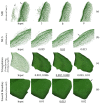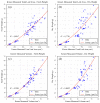Automatic Non-Destructive Growth Measurement of Leafy Vegetables Based on Kinect
- PMID: 29518958
- PMCID: PMC5876734
- DOI: 10.3390/s18030806
Automatic Non-Destructive Growth Measurement of Leafy Vegetables Based on Kinect
Abstract
Non-destructive plant growth measurement is essential for plant growth and health research. As a 3D sensor, Kinect v2 has huge potentials in agriculture applications, benefited from its low price and strong robustness. The paper proposes a Kinect-based automatic system for non-destructive growth measurement of leafy vegetables. The system used a turntable to acquire multi-view point clouds of the measured plant. Then a series of suitable algorithms were applied to obtain a fine 3D reconstruction for the plant, while measuring the key growth parameters including relative/absolute height, total/projected leaf area and volume. In experiment, 63 pots of lettuce in different growth stages were measured. The result shows that the Kinect-measured height and projected area have fine linear relationship with reference measurements. While the measured total area and volume both follow power law distributions with reference data. All these data have shown good fitting goodness (R² = 0.9457-0.9914). In the study of biomass correlations, the Kinect-measured volume was found to have a good power law relationship (R² = 0.9281) with fresh weight. In addition, the system practicality was validated by performance and robustness analysis.
Keywords: 3D reconstruction; Kinect v2; non-destructive; plant growth measurement; point cloud.
Conflict of interest statement
The authors declare no conflict of interest.
Figures
















References
-
- Lati R.N., Filin S., Eizenberg H. Estimation of plants’ growth parameters via image-based reconstruction of their three-dimensional shape. Agron. J. 2013;105:191–198. doi: 10.2134/agronj2012.0305. - DOI
-
- Andersen H.J., Reng L., Kirk K. Geometric plant properties by relaxed stereo vision using simulated annealing. Comput. Electron. Agric. 2005;49:219–232. doi: 10.1016/j.compag.2005.02.015. - DOI
-
- Lati R.N., Filin S., Eizenberg H. Estimating plant growth parameters using an energy minimization-based stereovision model. Comput. Electron. Agric. 2013;98:260–271. doi: 10.1016/j.compag.2013.07.012. - DOI
-
- Yeh Y.H.F., Lai T.C., Liu T.Y., Liu C.C., Chung W.C., Lin T.T. An automated growth measurement system for leafy vegetables. Biosyst. Eng. 2014;117:43–50. doi: 10.1016/j.biosystemseng.2013.08.011. - DOI
-
- Aksoy E.E., Abramov A., Wörgötter F., Scharr H., Fischbach A., Dellen B. Modeling leaf growth of rosette plants using infrared stereo image sequences. Comput. Electron. Agric. 2015;110:78–90. doi: 10.1016/j.compag.2014.10.020. - DOI
MeSH terms
LinkOut - more resources
Full Text Sources
Other Literature Sources
Research Materials

